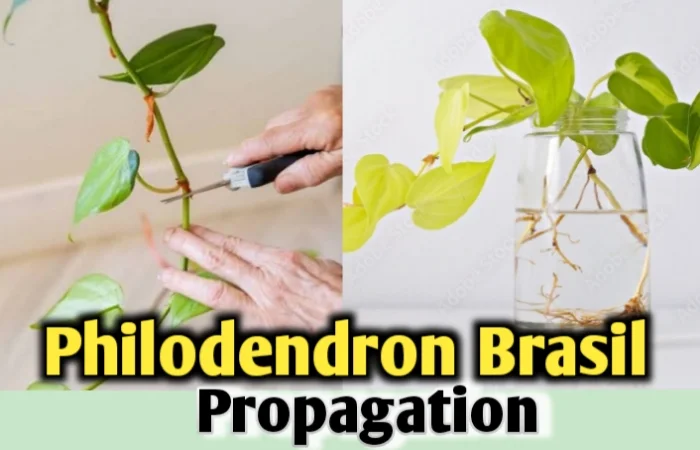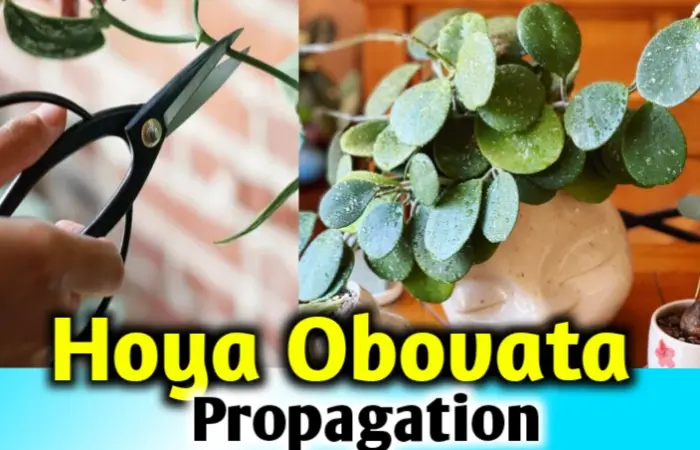How to propagate Cylindrical Snake plant? [Two methods-both water & soil]
Cylindrical snake plant propagation is one of the easiest propagation activities that you need for maintaining the quality of the plant that you already possess.
If you are thinking of propagating your snake plant, you should have some information that will make your propagation successful. But what are those?
The cutting of a single leaf upper from the rhizome or cutting of a portion of the mother plant with rhizome and roots can be used as propagation. After cutting, plant it in the previously prepared soil or water and wait for around 2 months. New roots will sprout from there.
The entire description of propagation is described here.
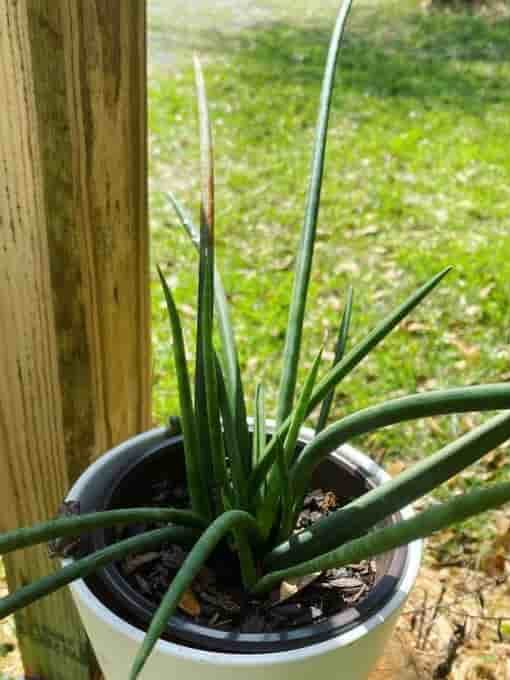
Cylindrical snake plant propagation
Before knowing about the cylindrical snake plant propagation, we should have some common ideas about the cylindrical snake plant.
Their,
- Scientific name- Dracaena angolensis or Sansevieria cylindrica.
- Other names- Spear sansevieria, African spear, Brazil saint barbara sword etc.
The cylindrical snake plant is a succulent plant. The process of commencing a new plant by planting a leaf-cutting is known as cylindrical snake plant propagation. A few materials will be needed for this purpose and consciousness is important.
Why do we need propagation?
Propagation is needed to retain the genuineness of a snake plant variety. Snake plants are unique houseplants that have some different variations. All of these varieties are not found every time and everywhere.
If you want to increase the number of your favorite snake plant, propagation is the best system. You need not be worried if the characteristics of the new plant will be the same or not.
The vegetative part, specifically the leaves, rhizomes, roots etc. carry the same characteristics as the mother plant. Whenever you plant a cutting, you need to ensure the proper caring of it.
How can I understand that my plant is ready for propagation?
All plants cannot always initiate a new life. Some definite characteristics should be present there if you want to choose a mother plant for propagation.
A mother plant generally exhibit the following conditions if they are matured enough for propagation-
Rootbound
Rootbound means the indication of a matured plant. If the pot size is small when you planted the new seedling, after gaining maturity, the roots may be congested there and they don’t get proper space to be nourished.
Roots become larger in the matured plant. So you can easily get an idea of your plant.
Healthy
The plant should be healthy enough so that it can initiate new roots. The overall growth, development and appearance of the plant can ensure the plant’s healthy condition.
The plant will be free from any kind of disease and other pale expressions.

Matured
The plant which is adequately matured contains propagules that are matured.
So the propagule that is enlarged and properly matured should be selected.
Disease-free
The mother plant or propagule should be 100% disease-free. Otherwise, the fungus or pest will be transferred to the new baby plant.
In the case of leaves, you should check the leaf growth and surface. The surface should be smooth and shiny. Any kind of blight or spots will not be seen.
Which is the best time for propagation?
The best time for propagation is in the early morning in a day. You will get some extra benefits this time than other times that will increase the possibility of the best growth of your material.
But what are the facilities? Let’s see.
Plant’s physiological processes
Transpiration, one of the physiological processes of the snake plants, remains low in the early morning or at dawn.
So, the possibility of wilting of the propagated material is almost zero. That’s why the dawn is best in this regard to decrease the transpiration and support the cutting for development.
Water absorption
Water uptake is facilitated at dawn because the excessive temperature will not remain in the morning time. So the dryness won’t be created and the new cutting will be able to get it.
Materials needed for propagation
To complete the propagation procedure, some materials will be needed. These materials should be disease-free and a perfect environment should be created for completing the propagation methods so that the cuttings cannot be affected during the activities.
Knife
A knife or a pair of scissors is needed to cut the propagule that will be used for propagation. It should be sterilized properly before using in the plant.
New pot
A new pot is needed for planting the new cutting. The pot should not be small-sized because if it is too small, the snake plant will face the problem of rootbound when it will start developing.
Jar
The jar is needed if the propagation is done in water. It should be made of crystal clear glass. The jar should be clean and free from any kind of dust.
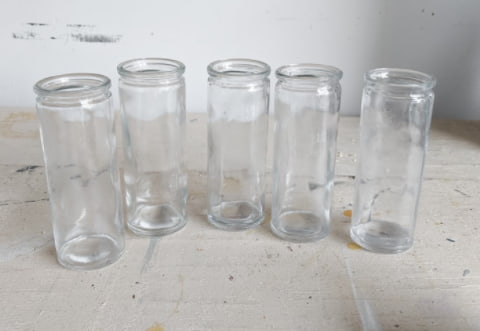
Watering cane
After planting the cutting, watering is to be done and a watering cane is needed here. It will help you to distribute water at a relevant proportion to all parts of the pot.
Polythene sheets
It is not always mandatory. But if you want to keep the cut plant parts in a place before planting, you should need a clean polythene sheet. But ensure fast planting to avoid any kind of contact that improves the risk of disease attack.
Prepared soil
Soil should be prepared by mixing peat moss. A ratio of 1:1:1:1 of perlite, coir, soil and peat moss will be best for the growth of the snake plant cutting.

Propagating procedures
Propagation procedures are of two kinds. Those are propagating by leaves and propagating by rhizomes. Both of the methods are quite beneficial despite having some more or fewer differences.
Before knowing the best method, I think we should discuss both of them and that will help to select one.
Propagation by offset or leaves
The easiest way of cylindrical snake plant propagation is propagating from the enlarged and swollen leaves of the plant. You can grow it in soil or water.
Growing in soil
The step by step description of propagating in the soil of cylindrical snake plant is mentioned here-
Step 1- Water the plant
Before cutting, water the mother plant properly so that the soil is wet. It is an important procedure to help the baby plant to grow.
Step 2- Separate the leaf
Choose a healthy mother plant and cut a leaf from the upper side of the rhizome. Rhizome means the stem of the plant. Then cut the leaf into small different parts. Try to keep the uniformity of the size in all the small parts.

Step 3- Planting
Plant all the cutting in the new pot where you have prepared the soil for it.

Step 4- Watering
Water the pot regularly but not often. Water it only when the soil is dry. Try to keep the pot in a semi-shady place to help the cutting to cope with the environment.
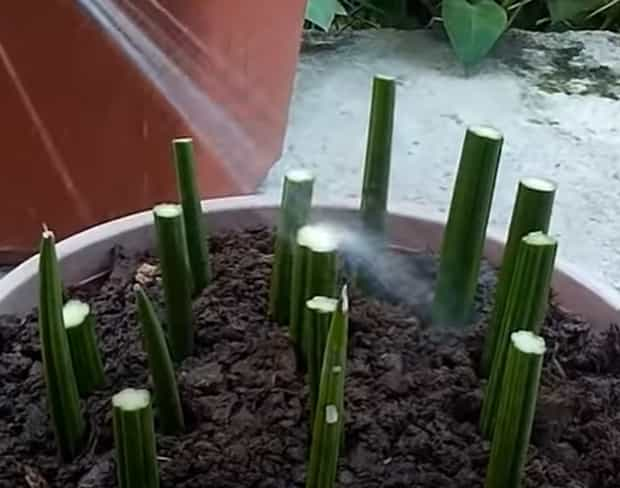
Step 5- Root initiation
Wait for around 2-2.5 months. New roots will be sprouted.

Growing in water
Growing in water facilitates root initiation. Many gardeners propagate their plant in the water and then transfer it to the soil medium. The procedure is the same as growing in the soil but just in water.
Though the plant takes some time to adapt to the different mediums, this procedure is getting popular nowadays.
Step 1- Cut the leaf
After choosing a healthy plant, cut a leaf and make small parts of it.
Step 2- Placing in the jar
Take a glass jar and mob it with a clean cloth. Fill the jar with water as much as the lower portions can be submerged in the water. Extra watering is not needed in this case.

Step 3- Coming out of roots
After waiting for around 2 months new roots will come out.

Propagation by rhizome
This procedure includes cutting from the mother plant with rhizomes and roots. This is also completed in the soil and water.
Growing in soil
The growing processes of soil are illustrated here-
Step 1- Cutting
Separate a healthy leaf consisting of roots from the mother plant. Remove the soil attached to it.

Step 2- Placing in soil
Plant the leaf in the prepared soil. The preparation of the soil is mentioned earlier.

Step 3- Watering
Water the plant with a watering cane or any other instruments convenient for you.
Step 3- Root growth
The new roots and shoots will grow from the cutting where you can see the lateral and upward growth of a four months’ baby plant.

Growing in water
Now, we will discuss the processings of rhizomes in the water.
Step 1- Cutting
A part of the plant that consists of leaf, rhizome and root should be separated.
Step 2- Clean the roots
Clean the roots with water and then brush to stop any type of mold growth.
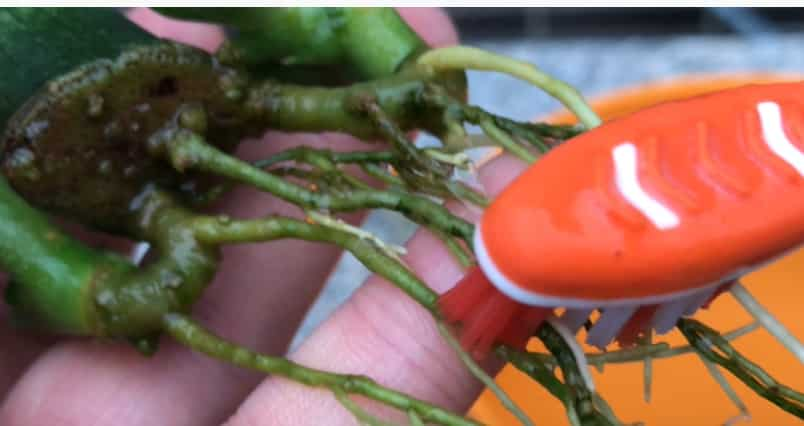
Step 3- Placing
Before placing, tie the part smoothly with a wire so that the whole cutting is not submerged in the water. Then place it in the water.
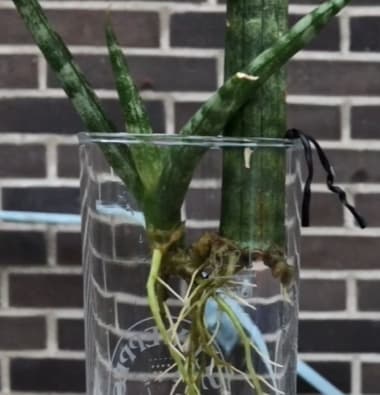
Step 4- Root initiation
The roots will be sprouted from the pre-existing roots. Additional leaves will also grow from the rhizome.
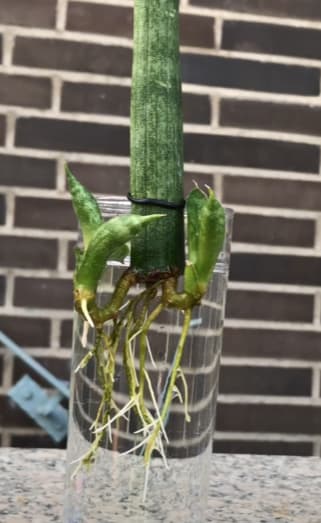
Which is the best method for propagation?
We have discussed some methods of cylindrical snake plant propagation. Different methods will suitable for different persons. But among them, leaf cutting in the soil method is supposed to be the best. Because the success of propagation is almost 100% in this system.
Though propagating in water initiate rooting faster than soil, but sometimes it may not germinate because of some reasons.
Rhizome cutting is also an appreciable method. So pick one as your convenience.
Is rooting hormone important for snake plant propagation?
Rooting hormone is important for root initiation. But cylindrical snake plants don’t require it too much. Still you can use rooting hormone after cutting and plating the cut part in the new pot.
A layer of 2 inches outside the cut part is best in case of using rooting hormone.
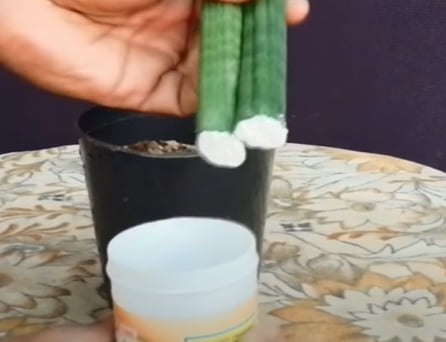
Causes of propagation failure
Propagation failure in cylindrical snake plant is almost zero. But still if you are unconscious, this can be happen because of pest attack or improper planting. If you fail to choose a right plant, it is suppressing for root initiation.
Sometimes some propagation may fail to grow up naturally.

Enjoy this video to be more clear about the propagation system.
Final thoughts
Cylindrical snake plant propagation is always enjoyable if you can give proper attention to it. There are various ways open for you. You havde to pick one of that and to use it properly.
So, remove the confusion and try it out. Don’t forget the precautionary measures as well. The new baby plants will emerge as your happiness.

